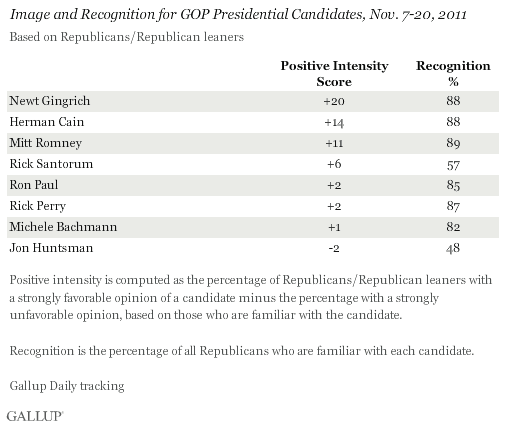PRINCETON, NJ -- Newt Gingrich now leads all of his Republican presidential rivals in garnering positive image ratings from Republicans and Republican leaners nationwide -- marking a first for 2011. His +20 Positive Intensity Score gives Gingrich a sizable lead over Herman Cain, in second with +14, and Mitt Romney, in third with +11.

Gallup computes Positive Intensity Scores by subtracting the percentage of Republicans with highly unfavorable views of each candidate from the percentage with highly favorable views, based on those who say they have heard of the candidate. Positive intensity is reported on the basis of continuous two-week rolling averages, with the latest results based on Gallup Daily tracking from Nov. 7-20.
Of the eight Republican hopefuls Gallup currently tracks, all but Rick Santorum and Jon Huntsman are now known by more than 8 in 10 Republicans. As recently as late September, Cain was as little known as Santorum -- recognized by 55% and 54% of Republicans, respectively -- but Cain subsequently surged in name recognition.
While Gingrich is the top-rated Republican on the basis of positive intensity, Gallup's latest update on Republicans' preferences for the 2012 GOP nomination finds the former House speaker roughly tied with Romney for the lead, with Cain close behind.
Republicans Rethink Gingrich as They Cool on His Rivals
Gingrich's position is remarkable for a candidate who five months ago saw his Positive Intensity Score collapse to the low single digits after beginning the campaign alongside Romney and Cain as the most well-liked candidates at the time.
Gingrich's Positive Intensity Score has advanced two to three points each week since mid-October, after it climbed slowly upward from August to October. At the same time, Romney's positive intensity has dwindled from +15 to +11 and Cain's has tumbled from +34 to +14. Cain's descent continued through last week, when he fell three points from +17.

Gingrich's ascent stands in contrast to not only Romney's and Cain's downward trends, but to the recently static positive intensity of Ron Paul, Rick Perry, and Michele Bachmann. All of these last three candidates now receive Positive Intensity Scores of +1 or +2 and all have been in the low to mid-single digits for at least a month, after periods of much higher ratings earlier in the campaign.

Bottom Line
Cain and, to lesser degrees, Bachmann and Paul are the 2012 Republican presidential candidates who have demonstrated that someone with a small but committed support base can, at least temporarily, emerge as a serious contender in the Republican presidential race. Perry proved that rank-and-file Republicans would readily welcome a new entrant to the Republican field, assuming that person met certain criteria. Huntsman and Santorum have shown that building name recognition and Republican support requires more than a solid résumé. And Romney has demonstrated that it is possible to maintain front-runner or near-front-runner status without generating a high degree of enthusiasm from the party base.
Gingrich now represents an entirely different kind candidate -- one who can fully recover after almost completely collapsing halfway through the race. Gingrich still has a way to go to convert the warm feelings Republicans have for him into active support for the nomination. As he works on that, he serves as a reminder that it may be premature to write off any of the Republican hopefuls whose positive intensity ratings have faded in recent months, including Perry, Paul, Bachmann, and Cain.
Survey Methods
Results are based on telephone interviews conducted as part of Gallup Daily tracking Nov. 7-20, 2011, with random samples of Republicans and Republican-leaning independents, aged 18 and older, living in all 50 U.S. states and the District of Columbia.
Questions asking about the eight potential candidates measured in this research were rotated among randomly selected samples of Republicans each night; over the 14-day period each candidate was rated by a minimum of 1,400 Republicans and Republican-leaning independents.
For the overall ratings of each potential candidate among Republicans and Republican-leaning independents, including recognition scores, one can say with 95% confidence that the maximum margin of sampling error is ±3 percentage points. For the Positive Intensity Score for each candidate, the maximum margin of sampling error varies depending on the size of the group recognizing the candidate.
Interviews are conducted with respondents on landline telephones and cellular phones, with interviews conducted in Spanish for respondents who are primarily Spanish-speaking. Each sample includes a minimum quota of 400 cell phone respondents and 600 landline respondents per 1,000 national adults, with additional minimum quotas among landline respondents by region. Landline telephone numbers are chosen at random among listed telephone numbers. Cell phone numbers are selected using random-digit-dial methods. Landline respondents are chosen at random within each household on the basis of which member had the most recent birthday.
Samples are weighted by gender, age, race, Hispanic ethnicity, education, region, adults in the household, and phone status (cell phone only/landline only/both, cell phone mostly, and having an unlisted landline number). Demographic weighting targets are based on the March 2010 Current Population Survey figures for the aged 18 and older non-institutionalized population living in U.S. telephone households. All reported margins of sampling error include the computed design effects for weighting and sample design.
In addition to sampling error, question wording and practical difficulties in conducting surveys can introduce error or bias into the findings of public opinion polls.
For more details on Gallup's polling methodology, visit www.gallup.com.
